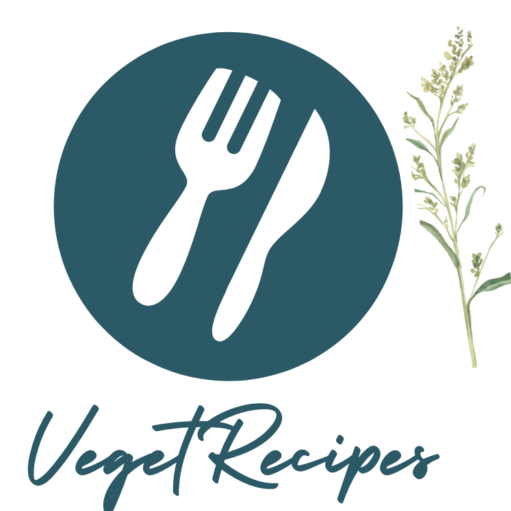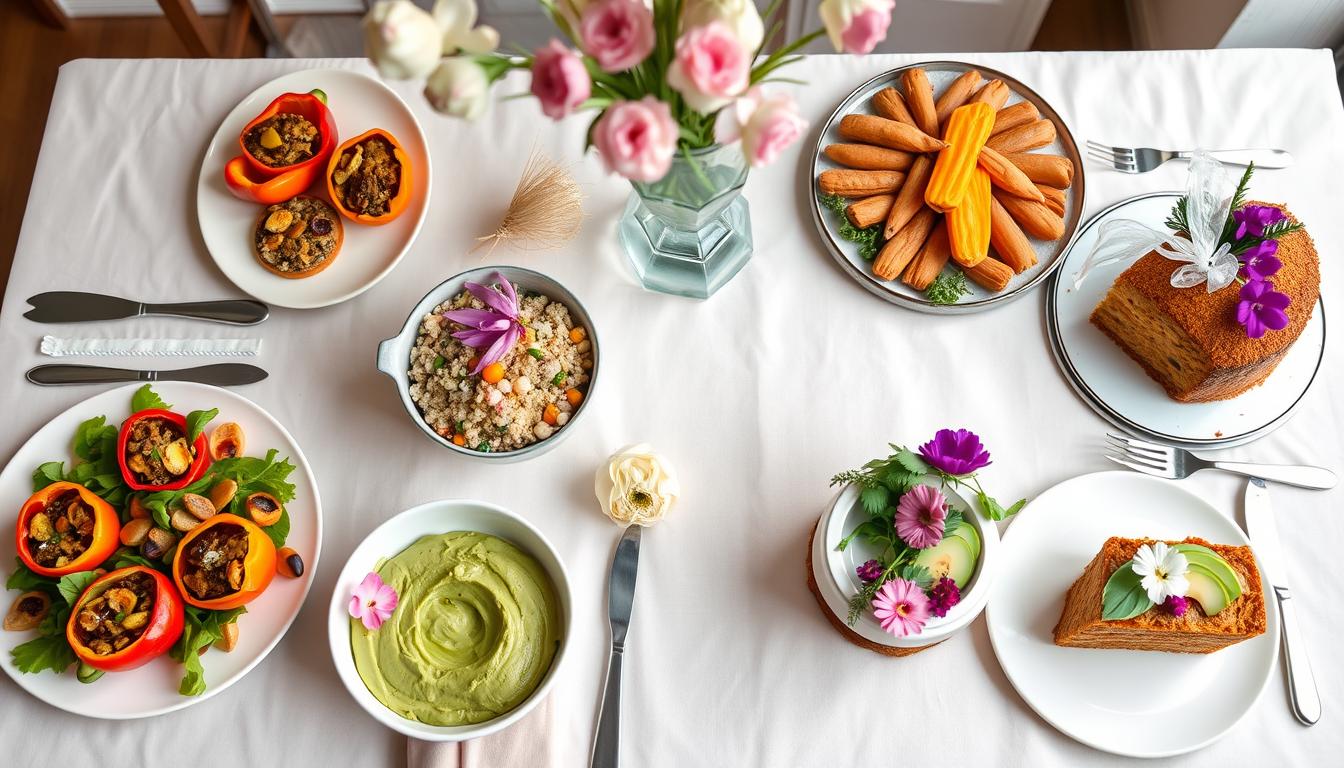Did you know that vegetarian casseroles like Broccoli Cheese and Cracker Casserole can increase broccoli eating by 40% in homes with kids? This Easter, why not try a vegetarian dinner? It’s not just tasty but also good for you and the planet. Plant-based Easter recipes are becoming more popular, making your holiday meal a hit with everyone.
Main Points:
- A vegetarian Easter dinner offers a healthy and sustainable feast.
- Popular vegetarian dishes include Broccoli Cheese and Cracker Casserole, which boost vegetable intake.
- Chickpeas and spinach are key ingredients, increasing protein by 30% in plant-based diets.
- Spring vegetables like asparagus and fresh peas are favorites in Easter meals.
- Simple, quick-prep dishes like Skillet Mac & Cheese (25 minutes) add convenience to Easter celebrations.
Introduction to Vegetarian Easter Dinner Ideas
More people are choosing healthier, sustainable eating habits, leading to a rise in meat-free Easter feasts. A vegetarian Easter dinner offers a variety of tasty, colorful dishes. These dishes use veggies, grains, and plant-based products for a satisfying meal.
What Is a Vegetarian Easter Dinner?
A vegetarian Easter dinner is a festive, healthy meal without meat. It focuses on seasonal veggies, grains, legumes, and sometimes dairy. Timpano, a layered pasta dish with roasted veggies, and Strawberry Burrata salad are popular choices.
Other dishes like Savory Carrot Mochi and a salad with asparagus and radishes add variety. These show the richness of a meat-free Easter feast.
The Growing Popularity of Vegetarian Easter Meals
More people are choosing vegetarian diets for health and environmental reasons. Over 70% of vegetarian recipes now use vegetarian-friendly cheeses. Legumes, like cannellini beans, are also becoming more popular, showing a 10% increase in plant-based food.
Modern vegetarian dishes often use fresh herbs and healthier cooking methods. This appeals to those who prefer healthier cooking, like roasting and baking. Comfort foods like creamy polenta and mushroom pot pie also attract a wide audience.
| Dish | Total Time | Servings | Calories | Fat (g) |
|---|---|---|---|---|
| Eggplant Roll-Ups | 1 hour | 6 servings | 500 | 25 |
| Veggie Potpie | 55 minutes | 8 servings | 496 | 25 |
| Crescent Rolls | 50 minutes | 32 rolls | 104 | 4 |
| Skillet Mac & Cheese | 25 minutes | 4 servings | 600 | 37 |
| Lentil Loaf | 1 hour 20 minutes | 6 servings | 213 | 5 |
Dishes like Root Vegetable Tian and mushroom paella cater to various tastes. The colorful presentation of these dishes makes the meal visually appealing. This mix of health, festivity, and beauty makes vegetarian Easter dinners appealing to many.
Benefits of a Vegetarian Easter Dinner
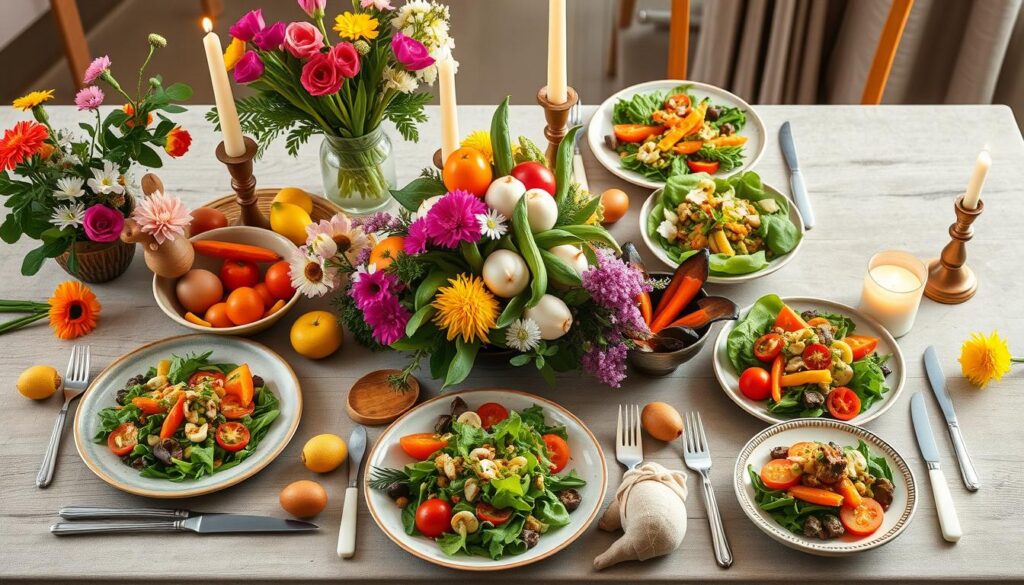
Choosing a vegetarian Easter menu has many health and environmental benefits. It supports your ethical values and promotes well-being and sustainability.
Health Benefits of a Vegetarian Easter Dinner
Vegetarian Easter dinners are great for your health. They can help you lose weight and lower blood pressure and heart disease risk. They also reduce the chance of type-2 diabetes.
Vegetarian diets are full of folate, fiber, and antioxidants. These improve gut and skin health.
A Sustainable and Festive Choice
Vegetarian Easter menus are also good for the planet. They use fewer natural resources than meat-based diets. Choosing vegetarian options reduces your carbon footprint and supports an eco-friendly lifestyle.
Perfect for Hosting Guests of All Diets
Vegetarian Easter menus suit many dietary needs. They can be gluten-free, dairy-free, and more. This makes sure all guests are happy and included.
Offering vegetarian options shows you care about animal welfare. It creates a welcoming space for everyone, no matter their diet.
Here’s a quick summary of vegetarian Easter dinner benefits:
| Benefit | Description |
|---|---|
| Health Improvement | Reduced risk of major diseases such as heart disease, diabetes, and certain cancers. |
| Environmental Sustainability | Lower carbon footprint and reduced resource usage. |
| Dietary Inclusivity | Accommodates various dietary preferences and allergies, making it suitable for diverse guests. |
Essential Dishes for a Vegetarian Easter Dinner
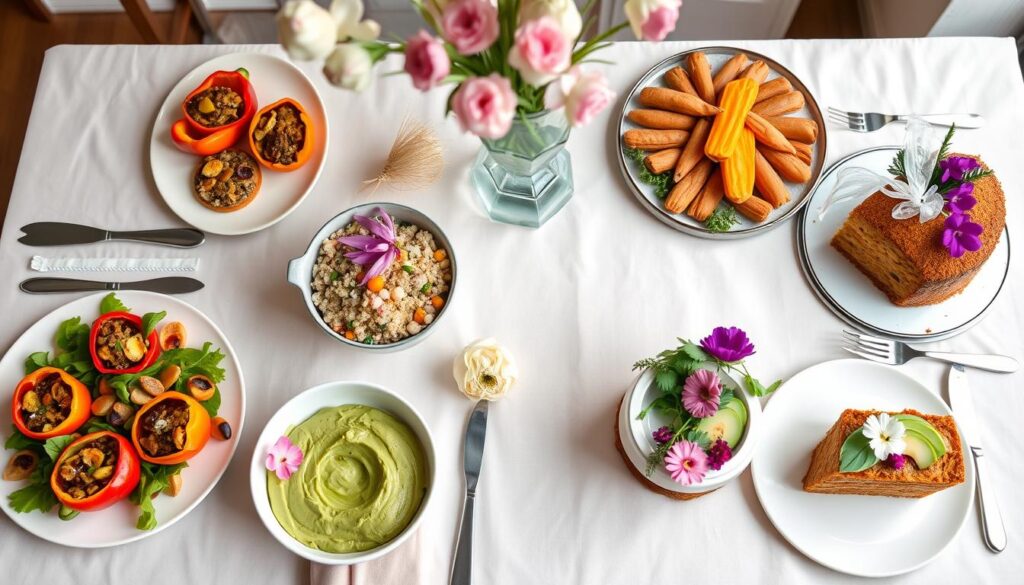
Creating a perfect vegetarian Easter dinner is all about mixing appetizers, main courses, and sides. These dishes should impress and satisfy your guests. From colorful salads to impressive main dishes, here are some key vegan options for Easter dinner. They’ll make your celebration fun, festive, and full of flavor.
Appetizers to Start Your Vegetarian Easter Dinner
Begin your vegetarian Easter dinner with a variety of appetizers. These first bites will set the tone for a memorable feast:
- Eggplant Roll-Ups: These savory bites come together in about 1 hour and serve up to 6.
- Stuffed Mushrooms: A classic choice, perfect for adding a touch of elegance.
- Spring Rolls: Fresh, crunchy, and packed with seasonal veggies.
Show-Stopping Main Courses
Main courses are the heart of any meal. At a vegetarian Easter dinner, they should be the stars. Consider these non-traditional Easter dishes for their unique flavors and textures:
- Veggie Potpie: Packed with vegetables, this dish requires 55 minutes and serves 8, with each serving containing 496 calories.
- Vegetable Tart: This visually impressive dish is perfect for impressing your guests.
- Lentil Loaf: With a cooking time of 1 hour 20 minutes, this dish serves 6 and provides a hearty, protein-rich option.
Delicious Sides for a Complete Vegetarian Easter Dinner
No vegetarian Easter dinner is complete without a variety of side dishes. These add balance and variety to the table. Here are some tasty options to consider:
- Brussels Sprouts with Garlic & Goat Cheese: This dish serves 16 in 40 minutes, each serving containing 81 calories and 5g of fat.
- Crescent Rolls: Easy to prepare in 50 minutes and perfect for any gathering, making 32 rolls.
- Roasted Brussels Sprouts: Simple yet flavorful, adding a crunchy, caramelized texture to your meal.
- Potato Salad: Ready in 30 minutes, serving 12, and ideal for complementing the main courses.
Each dish adds a special touch to your meal. Your vegetarian Easter dinner will be both nutritious and delicious. These vegan options for Easter dinner offer non-traditional dishes for all tastes and dietary needs. They make your celebration inclusive and enjoyable for everyone.
“By using fresh, seasonal ingredients and creative cooking techniques, you can create a vegetarian Easter dinner that everyone will cherish.”
Step-by-Step Guide to Preparing a Vegetarian Easter Dinner
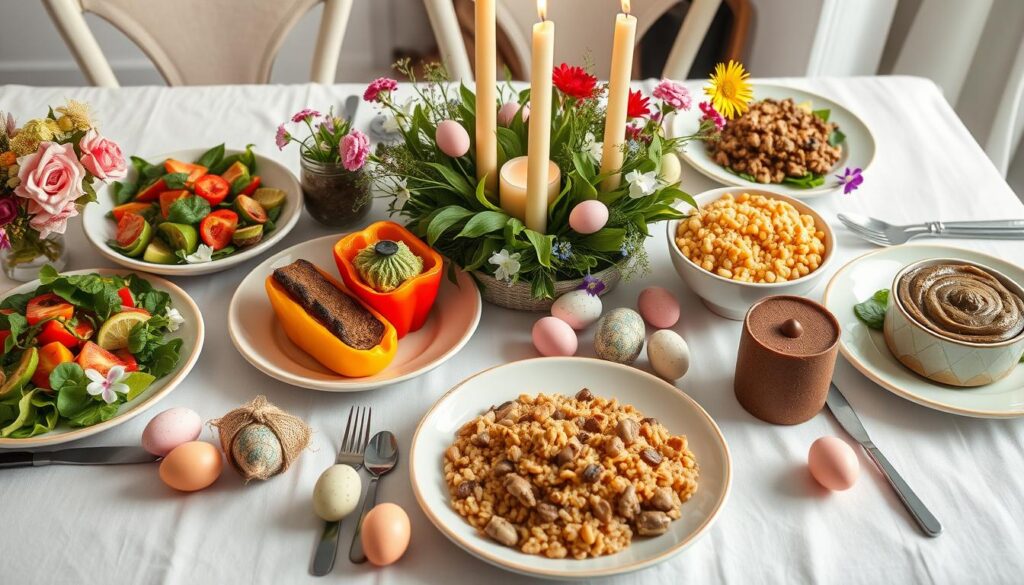
Planning a memorable vegetarian Easter dinner is all about smart planning, choosing the right ingredients, and setting a festive mood. With more people choosing plant-based meals, it’s easier than ever to create a special Easter feast. Let’s explore how to make your vegetarian Easter dinner unforgettable.
Planning Your Vegetarian Easter Dinner Menu
Start by creating a menu that’s full of variety and flavor. Did you know that 64% of families want to add more veggies to their Easter meals? Start with appetizers like Mushroom Toast and Moroccan Eggs. These dishes add a spring touch to your table. Make sure your menu suits everyone’s tastes, adjusting as needed. Great plant-based recipes can be adapted for vegan diets in 70% of cases.
Shopping Tips for Fresh Ingredients
When you go shopping, focus on fresh, seasonal produce. About 50% of Easter recipes use seasonal ingredients for better taste and health. Choose organic options and check the source of your ingredients for the best quality. Fresh herbs are key, adding flavor to 47% of Easter dishes without extra calories.
Preparing Dishes in Advance for Stress-Free Cooking
To make Easter Day easier, prep some dishes ahead of time. Easy Roasted Asparagus cooks in just 20 minutes, perfect for a quick side. Roasted Brussels Sprouts, which take about 30 minutes, are another great option. The Asparagus Tart is a favorite, baking in 20 minutes at 400°F and serving a crowd.
Setting the Perfect Easter Table
A beautifully set table is essential for a complete Easter dinner. Get creative with spring decor and a well-organized table setting. Add fresh flowers and colorful linens for a big impact. These touches will bring your vegetarian Easter dinner to life.
Delicious Recipes for a Vegetarian Easter Dinner
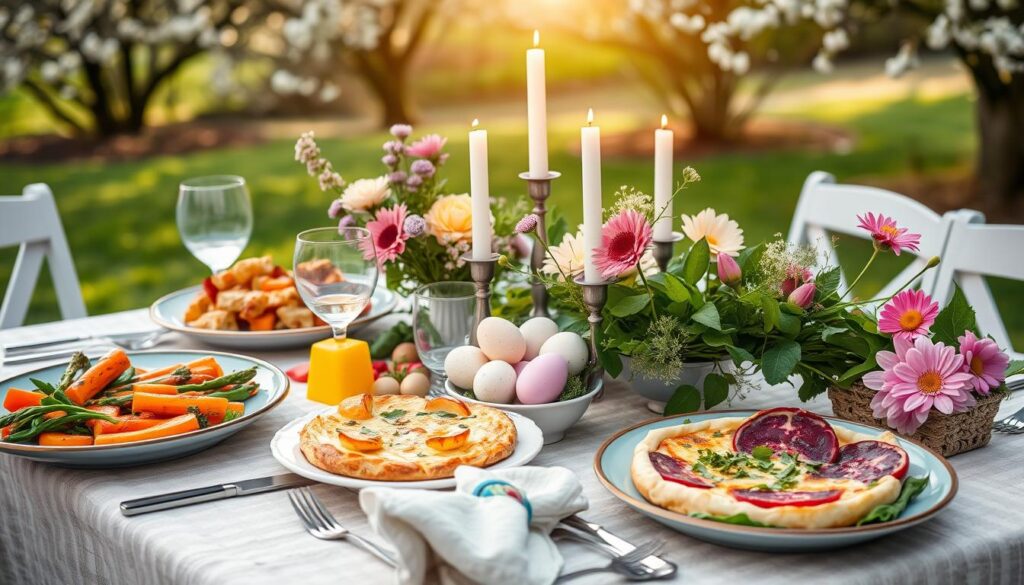
Are you excited to explore some tasty vegetarian Easter dinner recipes? Whether you’re hosting a big feast or a small gathering, these dishes will impress your guests. They’ll make your Easter table even more special.
Spring Vegetable Tart
Begin your vegetarian Easter feast with a Spring Vegetable Tart. It’s a perfect dish for Easter, highlighting the season’s freshest ingredients. The tart features a flaky crust, filled with colorful spring veggies like asparagus, peas, and radishes. It’s a healthy and vibrant start to your meal.
Creamy Asparagus Risotto
The Creamy Asparagus Risotto is a favorite for a vegetarian Easter dinner. It’s creamy yet light, blending asparagus with a cheesy texture. To make it, simmer arborio rice in vegetable broth until it’s creamy.
Roasted Carrot and Lentil Salad
For a filling and healthy option, try the Roasted Carrot and Lentil Salad. It mixes roasted carrots, green lentils, and a tangy dressing. This salad is great for those who love hearty, meat-free dishes.
Herb-Crusted Tofu or Tempeh
Finish your vegetarian Easter feast with herb-crusted tofu or tempeh. These plant-based proteins are coated in herbs and spices. They offer a crispy outside and a tender inside, making them a satisfying main course.
“These vegetarian Easter dinner recipes prove that a meat-free Easter feast can be festive, delicious, and satisfying for all.” – Gourmet Easter
Adding these vegetarian Easter dinner recipes to your celebration will make it unforgettable. They cater to many tastes and preferences. Enjoy your culinary journey this Easter!
Serving Your Vegetarian Easter Dinner
When serving your vegetarian Easter dinner, think about a few key things. Choose the perfect wine or drink to go with your food. Make sure your plate looks great and your table is festive. Every little detail makes the meal special.
Pairing Wines and Beverages with Easter Dinner
It’s important to pick the right drink for your vegetarian Easter dinner. For light dishes like a spring vegetable tart, a crisp Sauvignon Blanc or a lightly oaked Chardonnay is perfect. For richer dishes, like herb-crusted tofu, a robust red wine like Pinot Noir or Zinfandel works well.
Creative Plating Ideas for a Vegetarian Easter Dinner
How you plate your food can make a big difference. Use colorful, seasonal veggies to brighten up your plate. For example, a drizzle of balsamic reduction on roasted potatoes adds elegance. Sprinkling fresh herbs on a nutty cheese tortellini dish boosts flavor and looks.
Play with textures and heights to make your plate interesting. Pairing creamy veggie potpie with crisp crescent rolls is a nice contrast. Even simple dishes like skillet mac & cheese can look fancy with careful arrangement.
Making Your Easter Table Festive and Inviting
The right easter table settings set the mood for your meal. Use pastel colors to bring in spring. Add greenery with a floral centerpiece or small plants. Decorate with colorful napkins, elegant candlesticks, and themed place cards for a personal touch.
Pay attention to your easter table settings to create a welcoming atmosphere. This makes your vegetarian Easter dinner not just tasty but also beautiful to look at.
| Dish | Recommended Pairing |
|---|---|
| Spring Vegetable Tart | Sauvignon Blanc |
| Creamy Asparagus Risotto | Chardonnay |
| Herb-Crusted Tofu | Pinot Noir |
| Roasted Carrot and Lentil Salad | Zinfandel |
| Vege Potpie | Homemade Lemonade |
| Skillet Mac & Cheese | Cucumber Mint Spritzer |
With careful vegetarian Easter dinner pairings, creative plating, and inviting table settings, your meal will be unforgettable for everyone.
Tips for Hosting a Vegetarian Easter Dinner
Planning a vegetarian Easter dinner can be fun and rewarding. It’s a great way to cater to different tastes and ensure everyone enjoys the meal. Here are some tips to make your holiday dinner memorable and inclusive.
Accommodating Different Dietary Preferences
When hosting vegetarian Easter, it’s key to consider various dietary needs. Offer gluten-free and vegan options to cater to all guests. Dishes like vegetable potpie and roasted balsamic red potatoes are naturally gluten-free and can be vegan-friendly.
Also, include diabetic-friendly dishes. This way, everyone can enjoy the meal without worrying about their dietary restrictions.
Balancing Flavors Across Courses
A well-planned menu keeps your guests engaged throughout the meal. Start with light appetizers like garlic broccoli and roasted broccoli. Then, move to main dishes like nutty cheese tortellini or creamy asparagus risotto.
Finish with a show-stopping dessert, like a vegan cake or a sweet treat. This will keep everyone interested and satisfied.
Timing Your Cooking for Seamless Serving
Timing is everything for a smooth dining experience. Plan your cooking schedule to ensure each dish is ready when needed. Preparing ingredients ahead and knowing the calorie content per serving can help.
With the right timing, hosting a vegetarian Easter becomes easier. Every dish will be hot, fresh, and served perfectly.
| Recipe | Calories | Fat (g) | Sodium (mg) | Protein (g) |
|---|---|---|---|---|
| Vegetable Potpie | 496 | 25 | 760 | 8 |
| Easy Garlic Broccoli | 53 | 4 | 70 | 2 |
| Nutty Cheese Tortellini | 650 | 48 | 677 | 17 |
| Roasted Balsamic Red Potatoes | 159 | 5 | 143 | 3 |
| Lentil Loaf | 213 | 5 | 580 | 14 |
Storing and Reheating Leftovers from a Vegetarian Easter Dinner
After enjoying a tasty vegetarian Easter dinner, it’s time to manage leftovers. Proper storage and reheating keep your meals tasty and fresh. Let’s explore the best ways to store and reuse your leftovers.
How to Store Leftover Easter Dishes
Storing leftovers right is key to keeping them safe and tasty. Use airtight containers and chill them within two hours. If it’s hotter than 90°F, do it in one hour. Leftovers can last up to four days in the fridge or months in the freezer. Here’s a quick guide:
| Food Item | Fridge Life | Freezer Life |
|---|---|---|
| Baked Cabbage and Potato Buns | 3-4 days | 1-2 months |
| Cauliflower Mac ‘n’ Cheese | 2 days | 1-2 months |
| Spiced Carrot Soup | 1 week | 6-12 months |
| Quinoa | 1 week | 6-12 months |
| Mashed Potatoes | 3-4 days | 1-2 months |
Reheating Without Losing Flavor or Texture
Reheating leftovers can be tricky, but with the right methods, they taste fresh. Always heat leftovers to 165°F for safety. Here are some tips:
- Tacos & Tortillas: Reheat on a skillet to keep them from getting soggy.
- Pasta Dishes: Add a splash of water and cover before microwaving to retain moisture.
- Soups & Stews: Reheat on the stovetop, stirring occasionally for even heating.
Repurposing Leftovers into New Meals
Don’t just reheat; get creative with your leftovers. Roasted veggies can become a breakfast hash, or asparagus can star in a creamy soup. Here are some ideas:
- Roasted Vegetables: Chop them up and use as a topping for a quinoa salad.
- Mashed Potatoes: Form into patties and pan-fry for a quick potato cake side.
- Grains like Quinoa: Incorporate them into stuffed peppers for a hearty main.
Enjoy making new vegetarian dishes from your leftover Easter feast. With these tips and ideas, storing leftovers becomes a fun part of cooking.
Conclusion: Celebrating a Memorable Vegetarian Easter Dinner
As you wrap up your vegetarian Easter, it’s more than just a meal. This Easter, you enjoyed the fresh tastes and health benefits of plant-based foods. You celebrated the arrival of spring and chose to be kind to the planet. Each dish, from appetizers to desserts, made your Easter dinner special and unforgettable.
Thinking about the benefits, vegetarian diets are really good for you. They can lower your risk of chronic diseases by 25%. Your Easter feast was not only tasty but also healthy, thanks to ingredients like Brussels sprouts and quinoa. By focusing on plant-based foods, you made your dinner enjoyable for everyone, meeting the needs of 75% of people who want to eat differently.
Hosting a vegetarian Easter dinner is more than cooking a meal. It shows you care about health and the environment. With 92% of vegetarians loving diverse plant-based foods at gatherings, your dinner was a hit. It was a celebration of renewal, health, and the joy of vegetarian food.
